Life in Japan
Observations on everyday life in Japan.
Note: some of the entries in this section are aimed at the "folks back home" and might not be terribly interesting for anyone living in Japan.
Thursday, February 14, 2008 5:48 PM
No, none in Tokyo today, though it's been a "hot" (hah) subject during the last couple of weeks due to the occasional freak precipitation event providing a couple of centimetres of wet, melty snow which vanished within a few hours of settling. However, I was browsing through this book in Kinokuniya earlier - it's a collection of photographs of postwar Japan taken by a photographer attached to GHQ (the US occupying authority), and one page showed pictures of winter in Tokyo a couple of years after the war. I can't reproduce them here, but back then they evidently had real snow in impressive amounts - maybe not quite as much as places like Niigata, but deep enough to have to dig paths through (rather than be scraped aside with little plastic shovels).
No photo today, but I have fixed another small problem with the comment posting function which - in rare cases - caused the comment to disappear after submission without any kind of error message. My apologies if anyone has experienced this: it was my anti-comment spam system being a little too enthusiastic.
Tuesday, January 29, 2008 5:47 AM
Anyone who's attempted to learn Japanese will probably have come
across the Jôyô Kanji (常用漢字), a prescribed list of 1945 kanji which
children in Japanese schools are required to learn, and which make up
the bulk of characters encountered in daily life and newspapers etc.
However, the list is fairly arbitrary and omits several important
characters such as 阪 (saka as in Osaka, and 奈 (na as in Nara), two geographical entities which aren't exactly unknown.
Proposals are afoot to expand the Joyo kanji list to 2000
characters by 2010 (the first revision since 1981) and the committee in
charge of this (文化審議会) is considering which ones to add. The other day
they published a proposal to add 11 kanji used in popular place names;
this is the full list:
Monday, January 21, 2008 7:13 PM
It's hard to believe now, but there were several periods during the early 1990s when I
lived entirely without any kind of telephone. I was living the mildly impoverished student
life in the former East Berlin, which was very cheap (the last place I lived in was a 45m2
apartment which cost maybe 12,000 yen a month at the exchange rate of the time). There
were some disadvantages though - apart from the coal heating, it was difficult to get a landline
until about 1995, because the former East German telephone system was so decrepit
Deutsche Telekom decided to rebuild it completely - which took a few years to cover all areas.
Mobile phones were around, but it would be another couple of years until they became
affordable. So understandably I was quite happy to find on arrival in Japan in 1996 that
mobile phones were widely available at reasonable prices.
Wednesday, January 16, 2008 5:32 PM
As Shari enjoys seeing pictures of other
people's places, and I happened to come across some old photographs,
here the interior of my first ever residence in Japan, dating from 1996:
Tuesday, January 15, 2008 9:46 AM
Does the fight against terror know no bounds? According to this
Kyodo article
posted on Japan Today, the Japanese government
is considering making Japanese language skills a requirement for foreigners applying for or renewing
long-term residence visas.
(Foreign Minister) Komura (高村) cited reasons such as the need for foreigners to be able to speak Japanese to fit into the Japanese society. While he gave no further explanation, the envisioned measure is believed to be aimed at eradicating illegal residency and likely part of antiterrorism policies.
"For foreign people living in Japan to be able to speak Japanese is not only important for improving their own quality of life, but also necessary for the Japanese society as a whole," Komura told a news conference.
"It would be a very good thing if this helps build momentum for learning Japanese language in the respective home countries of foreign people living in Japan," he added.
Thursday, November 15, 2007 7:56 PM
The smallest size of room you're likely to come across: a 3 tatami "Japanese-style" hotel room in
Osaka. It's actually more like 4 tatamis in size: at the doorway there's a little, lowered space for taking
your shoes off; and to the left of that a small area with wooden flooring where there's a small shelf
with a television set. I think there was an air-conditioning unit above the window.
Wednesday, May 25, 2005 10:24 AM
With over 6300 stores in Japan, FamilyMart (Family Mart) is one of the larger
players in the convenience store market. Founded in 1981, it was also
one of the earlier chains to expand into the various Asian markets,
opening its first Taiwanese store in 1998. It also has operations in South
Korea and Thailand.

FamilyMart - a Japanese convenience store
Link: http://www.family.co.jp/english/
Sunday, May 22, 2005 5:17 PM
Japan is the spiritual home of the convenience store, which is somewhat
surprising as the country's first konbini (コンビニ) - short for convenience - was opened as recently as 1974 in Tokyo. It was, by the way,
a 7-Eleven.
And here's another fact you might find surprising: 7-Eleven is a Japanese
company with subsidiaries around the world (including North America).
It used to be US-American (though the operations in Japan
were initiated by its then partner and now majority shareholder ItoYokado
- link) but the majority of shares were acquired by
ItoYokado in 1991.
7-Eleven is the largest convenience store chain in Japan with over
10800 stores (compared to fewer than 6000 in the USA, a country with more
than twice Japan's population).

One of more than 10,000 7-Eleven stores in Japan





